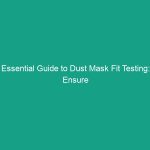Introduction
In today’s fast-paced work Environment, ensuring the Safety of employees is paramount. The field of Health, Safety, and Environment (HSE) emphasizes the importance of Workplace Safety, which is crucial not only for compliance with Regulations but also for the overall well-being of workers. One vital component of Workplace Safety is proper clothing, particularly high-visibility clothing. The significance of high-visibility clothing cannot be overstated as it plays a critical role in preventing accidents and keeping workers safe, especially in environments where visibility is compromised.
Understanding High-Visibility Clothing
High-visibility clothing is designed to make the wearer more visible in various working conditions. Typically made from fluorescent materials and reflective strips, these garments are essential for workers in industries such as construction, road work, and emergency services. The purpose of high-visibility clothing is to ensure that workers are easily seen by others, particularly in low-light or high-traffic areas. This section will delve deeper into the fundamentals of high-visibility clothing and its applications.
Types of High-Visibility Clothing
- Vests: Often worn by construction workers or road crews, these are lightweight and designed to be worn over other clothing.
- Pants and Jackets: These provide full-body coverage and are essential for workers exposed to elements or hazardous environments.
- Full-body Suits: Commonly used in emergency services, these suits offer comprehensive visibility and protection.
Materials Used
The materials used in high-visibility clothing are critical to their effectiveness. Most garments are made from synthetic fibers that are both durable and lightweight. The fabrics are often treated to enhance their brightness in daylight and reflectivity at night. Common materials include polyester and nylon, which are not only visible but also breathable and comfortable for the wearer.
The Regulatory Framework for High-Visibility Clothing
Understanding the regulatory landscape surrounding high-visibility clothing is essential for compliance and Safety. Various organizations and governmental bodies have established guidelines and Standards to ensure that high-visibility clothing meets specific safety criteria. This section will explore the key regulations and their implications for employers and employees alike.
International Standards
Several international standards govern the use of high-visibility clothing. The most notable include:
- ISO 20471: This standard specifies the requirements for high-visibility clothing worn by professional workers.
- ANSI/ISEA 107: In the U.S., this standard outlines performance requirements for high-visibility safety apparel.
Employer Responsibilities
Employers are responsible for ensuring that their workers are provided with appropriate high-visibility clothing. This includes conducting a risk assessment to determine the level of visibility required for specific job functions. Employers must also ensure that the clothing meets the necessary standards, is properly maintained, and is worn correctly by employees.
Best Practices for Implementing High-Visibility Clothing
For high-visibility clothing to be effective, organizations must adopt Best Practices in its implementation. This section will discuss practical tips for integrating high-visibility clothing into Workplace Safety programs.
Conducting Risk Assessments
A thorough risk assessment is the first step in determining the need for high-visibility clothing. Employers should regularly evaluate working environments to identify Hazards that may affect visibility. This assessment should consider factors such as lighting conditions, traffic patterns, and the nature of the work being performed.
Training and Awareness
Training employees on the importance of high-visibility clothing is crucial. Workers should be informed not only about the proper use of these garments but also about the risks associated with not wearing them. Additionally, regular refresher Training can help maintain awareness and compliance.
Case Studies Highlighting the Impact of High-Visibility Clothing
Real-world examples can effectively demonstrate the significance of high-visibility clothing in preventing accidents and injuries. This section will present case studies that showcase the positive impact of proper visibility in various work settings.
Case Study 1: Construction Site Safety
At a major construction site in New York, the implementation of high-visibility clothing significantly reduced incidents of near-misses. Workers were required to wear reflective vests and shirts, which made them easily identifiable amidst heavy machinery and vehicles. After six months of enforcement, the site reported a 40% decrease in accidents related to visibility.
Case Study 2: Road Work Zones
In a series of road construction projects across California, the use of high-visibility clothing was mandated following several accidents involving motor vehicles and construction workers. The adoption of highly visible jackets and pants resulted in a stark reduction in accidents by over 50%, showcasing the critical role visibility plays in worker safety.
Challenges in High-Visibility Clothing Compliance
While high-visibility clothing is a crucial safety measure, there are challenges in ensuring compliance and effectiveness. This section explores some common obstacles organizations face.
Employee Resistance
Some employees may resist wearing high-visibility clothing due to comfort or style preferences. It is essential for employers to address these concerns by offering a range of options that balance safety with comfort. Solicit employee feedback on clothing choices to ensure that all workers feel satisfied with the options available to them.
Maintenance and Durability
High-visibility clothing must be properly maintained to retain its effectiveness. This includes regular washing and inspection for wear and tear. Employers should establish a Maintenance schedule and provide guidance on proper care to ensure that clothing remains in good condition and continues to meet safety standards.
Future Trends in High-Visibility Clothing
The landscape of high-visibility clothing is continuously evolving, with advancements in technology and materials enhancing Safety Measures. This section discusses emerging trends that could shape the future of high-visibility clothing in the workplace.
Smart High-Visibility Clothing
Technological advancements are leading to the development of smart high-visibility clothing that incorporates features such as built-in lights, sensors, and connectivity to alert others about the wearer’s presence. This innovation could significantly enhance safety in hazardous environments.
Eco-Friendly Materials
With an increasing focus on Sustainability, manufacturers are exploring eco-friendly materials for high-visibility clothing. Using recycled fabrics and sustainable production processes not only Benefits the environment but also appeals to a growing demographic of environmentally-conscious consumers.
Conclusion
In conclusion, the significance of high-visibility clothing cannot be emphasized enough in the context of Workplace Safety. By adhering to regulatory frameworks, implementing Best Practices, and learning from case studies, organizations can enhance the safety of their workers. While challenges exist, the future of high-visibility clothing looks promising with innovations on the horizon. It is imperative for employers to prioritize the use of high-visibility clothing and foster a culture of safety that protects every worker. Let’s take proactive steps to ensure that all employees are equipped with the necessary tools to stay safe on the job. Together, we can make our workplaces safer for everyone.


